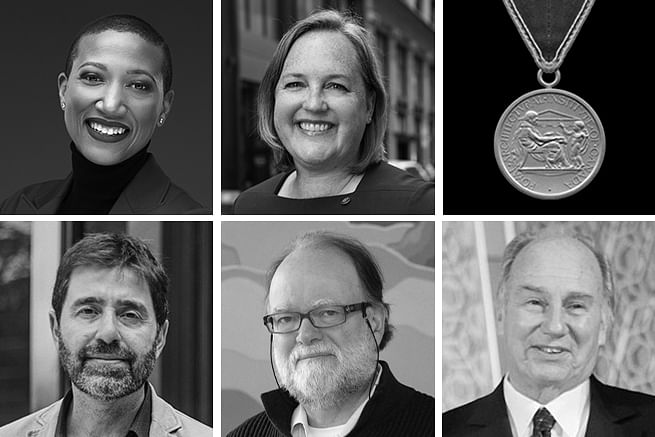Five names added to the RAIC College as new Honorary Fellows for 2025
By Josh Niland|
Thursday, Mar 27, 2025

Related
The 2025 class of Royal Architectural Institute of Canada (RAIC) Honorary Fellows has been announced by Canada’s oldest and most visible professional architectural association.
The five architects to receive the honor, which denotes their elevation to the RAIC College, all are Honorary Members of the RAIC and will remain on as Fellows for life in recognition of their outstanding contributions to the professional community both domestically and abroad.
This year’s list of Honorary Fellows includes former American Institute of Architects (AIA) presidents Kimberly Dowdell and Emily Grandstaff-Rice; the Chicago-based academic Michelangelo Sabatino; University of Victoria professor Martin Segger; and His Late Highness, Prince Aga Khan IV, who passed away this February at the age of 88. Each joins the 43 other newly named Fellows in the RAIC College and last year's elevation of Adele Weder, Yvonne Hancock, Claire Weisz, Lesley Lokko, and the late Claude Cormier.
Fellows and Honorary Fellows will be officially inducted to the RAIC College on Tuesday, June 3rd, via a live ceremony in Montreal. The 2025 Honorary Fellows citations are below.
Emily Grandstaff-Rice
"Emily’s work extends beyond leadership into transformative contributions in architecture and education, making a tangible difference in communities' lives. She has managed and designed projects across a wide spectrum, from educational institutions to museums, each reflecting her dedication to creating spaces that inspire learning, joy, and comfort. Her influence has shaped new educational programs, enhanced leadership development, and sparked critical strategic thinking among architectural professionals."
Kimberly Dowdell
"As the driving force behind the AIA’s Chief Architect initiative, Kimberly has pioneered partnerships with the U.S. Conference of Mayors, embedding architects within city governments to champion urban solutions to address climate, housing, adaptive reuse, and sustainable transit challenges. Building from the momentum of her predecessors, Kimberly’s work on federal procurement reform led to raising a long-standing fee cap on design services. This groundbreaking achievement will not only benefit architects across the U.S., but it is expected to have positive implications for architects globally. Beyond her professional role, Kimberly’s dedication to mentorship and community engagement shines brightly. She speaks to students of all ages, inspiring future architects by sharing her journey and advocating for diversity in the profession of architecture."
Michelangelo Sabatino
"Throughout his career Sabatino has focused new light on larger patterns of design discourse and production during the twentieth century in Canada, the USA, and Europe. His first book Pride in Modesty: Modernist Architecture and the Vernacular Tradition in Italy (2011) was translated into Italian and won multiple awards, including the Society of Architectural Historians’ Alice Davis Hitchcock Award. Sabatino has contributed to numerous award-winning books, including a survey entitled Canada: Modern Architectures in History (with Rhodri Windsor Liscombe, 2016); a book about Arthur Erickson is forthcoming."
Martin Segger
"Segger's five-decade career as an architectural historian, preservationist, civic advocate, professor, author and museum curatorial specialist has placed him amongst the leaders of recent and current distinguished Canadian architectural advocates and educators. While well known in various international academic institutions, organizations and affiliated scholarly communities of history and research, Martin’s influence and renown has been particularly felt in his home of Victoria, British Columbia and throughout the Pacific Northwest. He has been most highly regarded for his tenure as Associate Fellow, Centre for Global Studies at the University of Victoria, a position that has enabled his passion for the regional built environment to be featured through many books, talks and media coverage. Martin’s coverage of the built environment is well known through guides and feature publications that have made Victoria’s rich architectural heritage accessible to residents, students and interested visitors."
His Late Highness Prince Karim Aga Khan IV
"His Late Highness the Aga Khan was the 49th hereditary Imam (spiritual leader) of the Shia Ismaili Muslims and Founder and Chairman of the Aga Khan Development Network (AKDN), one of the largest private development agencies in the world. Since taking on his role as Imam in 1957, the Aga Khan has been deeply engaged in improving the quality of life of the most vulnerable populations, while emphasizing the need to uphold human dignity as well as respect for tolerance and pluralism. The AKDN is active in over 30 developing countries employing some 96,000 people with the support of tens of thousands of volunteers. The Network’s underlying ethic is that of compassion for the most vulnerable in society and service to humanity without regard to faith, origin or gender. His Late Highness the Aga Khan created the Aga Khan Award for Architecture established in 1977. It is given every three years to projects that set new standards of excellence in architecture, urban and regional design, conservation and landscape architecture. The Award seeks to identify and encourage building concepts that successfully address the needs and aspirations of societies in which Muslims have a significant presence."


Share
0 Comments
Comment as :